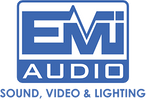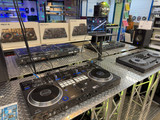Best Studio Studio Interfaces of 2021
Best Studio Studio Interfaces of 2021
So, you feel it is time to get yourself a nice studio interface and start recording. Plugging in your digital piano into your USB port or streaming your gameplay using your headphone´s integrated microphone is not doing the trick anymore and you want audio quality that sounds more professional.
Well, here are the best (affordable) studio interfaces in 2021. Let's start with the hottest interface of the last five years and get it out of the way.
Focusrite Scarlett 2I2

The Focusrite Scarlett 2i2 ticks all the boxes in terms of quality, features, and affordability, making it the most popular interface worldwide. The small red interface feels really well put together. With an all-metal chassis and well-adjusted dials, you will feel completely in control when operating the knobs, and the front buttons have a satisfying tactile response to them.
The red box has two frontal XLR combo jacks for your mics or instruments. The gain dials are surrounded by ring meters that flash red when you're clipping, so you know when to dial back.
If you want studio-grade sound, the Focusrite won´t let you down. They come with their signature AiR button, which is a feature normally reserved for their higher-end ISA preamps. This circuitry really brightens up the sound of your microphone by boosting the upper frequencies, delivering clear and transparent vocals and guitars.
This 3rd generation interface represents a smart move in terms of incremental upgrades without losing sight of what this interface was for. They reduced noise and latency while providing a clearer and more wholesome sound which was previously reserved for high-end studio interfaces. The Scarlett is an extremely well-rounded entry-level solution for those who want to start recording or streaming right away but would like to feel they're delivering great sound to their audiences from the start.
In short, the 2i2 is equipped with high-quality preamps, can record high-res audio to a maximum sample rate of 192Khz, and provides ample headroom so you can DI your guitars and record directly into your DAW. Its performance is amazing, with close-to-zero latency allowing you to monitor while you record without a problem.
The Focusrite is a really solid pick for under two hundred dollars.
PreSonus Audiobox iTwo
This one is the direct competitor and has a lot to unpack too.

The Presonus Audiobox 1Two is a surprisingly good, affordable interface. This small, compact, and light little box packs a lot of bang for the buck (and for its size). The finish and quality make it look like it is built like a tank, so you don't feel you're holding a cheap piece of equipment at all.
It comes with two combination XLR inputs for recording your mics and DIs simultaneously. They both have independent gain knobs and come with signal LED indicators that let you know when you're going too hot on the input and need to roll the gain back a bit.
The unit delivers plenty of gain for driving your dynamic microphones comfortably and the preamps are very high quality and quiet. This means you can drive them quite hot without noticeable hissing or popping noises in the background.
The knob in the middle is a direct control that allows you to bypass the unit´s latency and listen directly to your input. The variable potentiometer allows you to find the right combination between instruments and backing tracks as you play along.
Two great additions are the MIDI connectivity for your drum triggers or MIDI instruments; and the device link port that allows you to connect your iPad to the interface for a truly portable solution.
While the resolution is not that impressive at 96Khz, most of us are fine with recording at 44-48K, so the PreSonus brings more than enough processing power for today's standards. Definitely, a better option for sample creators or those who need better connectivity.
RME Babyface
Now this one is for the adults in the room. RME products are focused on quality instead of features, so these are usually only found in recording studios. However, the Babyface was designed to be as portable as possible without sacrificing the quality people associate with RMS products.

This small piece of hardware is machined out of a block of aluminum, so you can feel the robust build before you even open the box. It looks simple enough with a large multifunctional rotary dial right in the middle and clear multi-led displays. It has six completely assignable buttons that allow you to customize the interface and adapt it towards your particular needs on the go.
You can tell that RME puts a lot of attention to detail when you see how their cables are built. The unit comes with a right-angle USB StabiCon connector for a flush and robust connection. Their midi breakout cables also use this technology so you feel your connections are tight and flush 100% of the time. The near-zero latency of this interface is outstanding, even when running multiple tracks.
The Babyface comes with ADAPT I/O for additional outboard equipment when using it as a desktop studio interface.
The unit allows you to connect 2 XLR inputs, but these can be changed to ¼” inputs without a problem. There are two additional line inputs located on the side, along with 2 headphone outputs; a normal and a mini-jack.
The Babyface´s preamps offer a neutral, clean and truthful signal that some might describe as being too analytical. I, for one, prefer a pure sound that I can mold to my liking during processing, so I feel that RMS delivers the cleanest sound you can get from a small studio interface.
Their software is state-of-the-art and allows for incredible control and functionality. It comes with loopback features for streamers and can also be controlled directly from an iPad through a special connector that comes with the unit.
The RMS Babyface is not cheap, but it is worth every penny if you´re looking for a professional studio interface for recording and mixing on the go. It comes with a sturdy carrying case which adds to the portability side of the unit.
Those are the best studio interfaces for singers, songwriters, streamers, and studio owners who want more portability without sacrificing quality. If you want to know more, browse through our website or give us a call. We are always happy to offer professional advice about the best studio interface for your particular needs.
Recent Posts
-
New gear November
This Black Friday, we're open from 10am-2pm. Shop local and shop small! …Dec 1st 2025 -
Rental Price sheet for 2025. Call to reserve your gear today!
EMI Audio Rental Prices August 2025 Rates shown are 1-5 days for the Same Price & 30 day rate …Aug 26th 2025 -
DJ Demo Stations at EMI Audio
Did you know? - We have working demos available for practice or demo! Want to learn how to mix o …Jul 17th 2025




